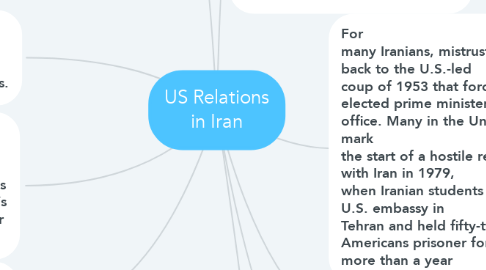US Relations in Iran
par Raynise Williams


1. Congress passed a law banning future aid to be sent to the anticommunist rebels in Nicaragua, known as the Contras.
1.1. To get around the ban, members of Pres. Reagan’s staff secretly sold weapons to Iran and used the profits to fund the Contras.
2. Considered to be a reformist, Rouhani entered into negotiations with the United States to end economic sanctions against Iran in exchange for Iran’s commitment not to build nuclear weapons.
3. US withdrew from agreement to continue economic sanctions and cut Iran off from global market Iran restarted its nuclear enrichment program in 2019.
4. On January 3, 2020, a U.S. drone strike assassinated General Qasem Solomeini, the head of the Quds Force of the Iranian Revolutionary Guard Corps, while he was traveling in Iraq. While the United States government had said that he was a terrorist, he was seen as a hero by some in Iran. President Trump claimed the drone strike was necessary, arguing that Solomeini represented an imminent threat to U.S. soldiers in the region. The drone strike caused shock and anger in Iran. Tensions between the two countries, already extremely high, threatened to boil over and lead to war.
4.1. The exchange of threats between the leaders of both countries raised the possibility that both countries would begin an “escalatory spiral” of increasing violence that would lead to an all-out war. On January 8, 2020, Iran launched a missile attack against two U.S. air bases in Iraq, but there were no U.S. or Iraqi casualties. After the missile attack, Iran’s foreign minister announced that Iran had completed its response and did not want war. President Trump responded the next day that the United States wanted peace.
5. The United States views Iran as an adversary in conflicts in the Middle East. U.S. policymakers see Iran as a threat to the security of Israel and Saudi Arabia, two important U.S. allies. Iran has backed Bashar al-Assad’s government in the Syrian Civil War, as well as groups in Yemen and Iraq who are fighting U.S.-backed groups
5.1. Iranian perceptions of the United States and U.S. policy are complex and vary across the population. The Iranian government’s primary goal is to protect itself from perceived security threats. The Iranian government sees the United States and its allies as a major threat to Iran’s security.
5.2. The Iranian government also provides support to the militant group Hezbollah, which the United States and the European Union consider to be a terrorist organization.
6. The U.S., Russia, China, Great Britain., France and Germany reached an agreement with Iran in July of 2015 that would limit Iran’s ability to develop nuclear weapons
6.1. Iran agreed to enrich only enough uranium to provide electricity for the nation, but not enough to develop nuclear weapons.
6.1.1. Iran also agreed to eliminate their stockpile of enriched uranium by 97% and to allow the International Atomic Energy Agency (IAEA) to regularly inspect Iran’s nuclear facilities.
